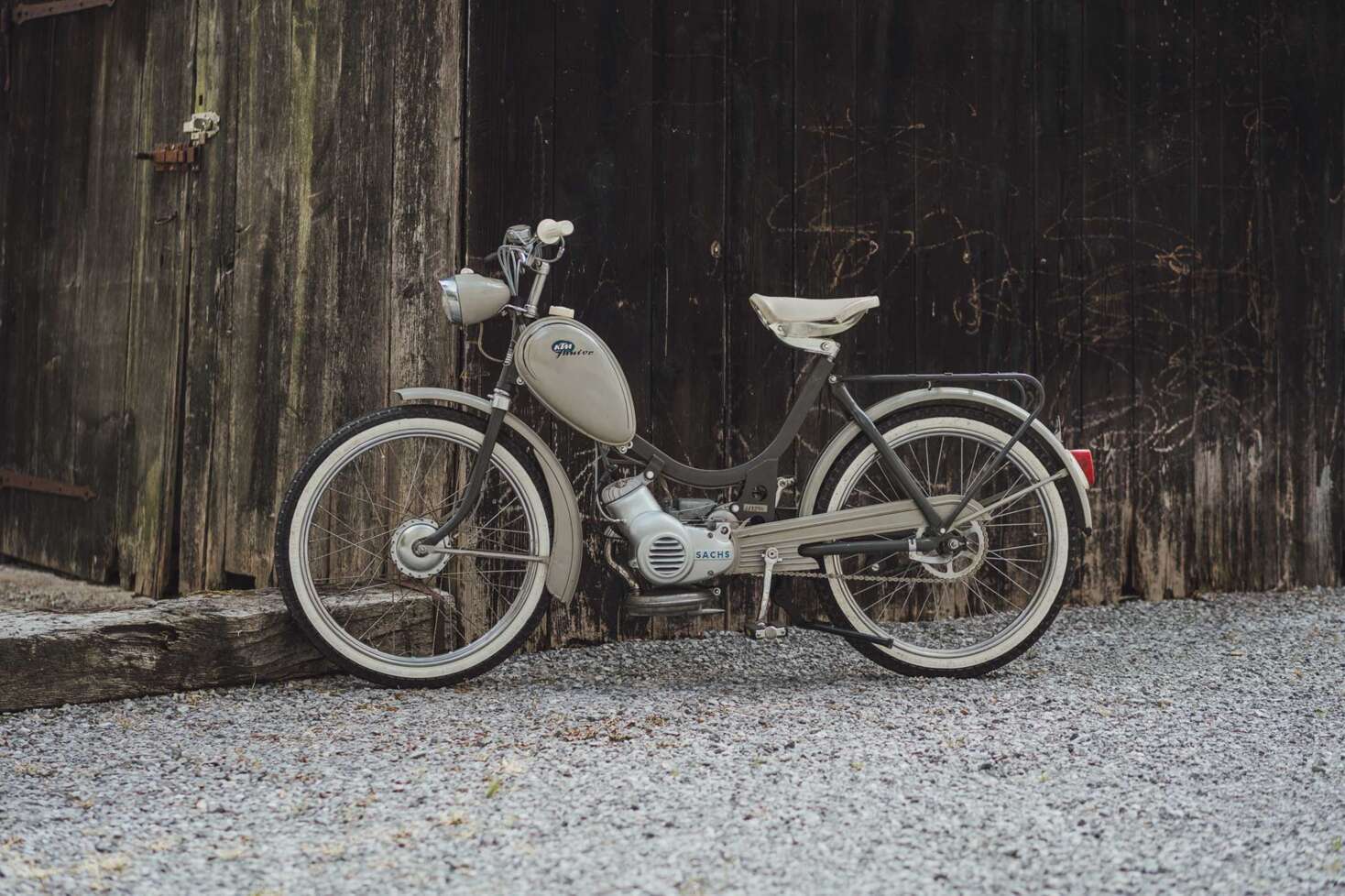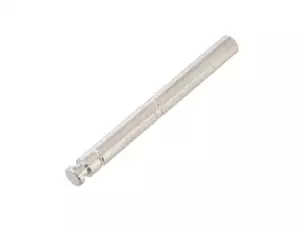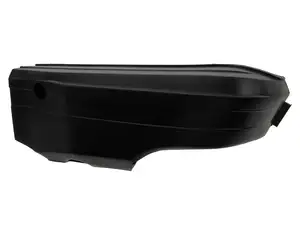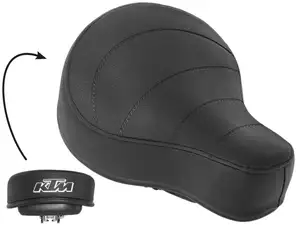
KTM
KTM - The legendary cross specialist from Austria

When it comes to mopeds from Austria, every motorbike enthusiast is sure to think of Puch. However, our eastern neighbour was also home to other renowned moped and motorbike manufacturers in its heyday that are still remembered today. KTM Motor-Fahrzeugbau KG is certainly one of them. We have KTM's engineers and designers to thank for the endearing Foxi moped, the reliable Hobby model and the GP40 motorbike. The Austrian two-wheeler manufacturer also took over the final assembly of the famous Pony mopeds from the manufacturer Amsler & Co. AG. We introduce you to the manufacturer, its history and its most famous mopeds in more detail.
| Seat |  |
| Status | |
| Foundation | 1934 |

Company founding and early years
Kraftfahrzeuge, Trunkenpolz, Mattighofen, or KTM for short, was the name of the locksmith's workshop that Hans Trunkenpolz founded in the aforementioned Austrian town in 1934. The company founder initially worked personally on bicycles, motorised two-wheelers and motor vehicles of all kinds to get them back in shape. The business flourished and the company founder soon entered the vehicle trade. Trunkenpolz sold the popular DKW motorbikes and Opel cars. A complete success and the rise of his young company continued seamlessly. Even the terrible Second World War did nothing to change this. However, instead of selling two-wheelers and cars, the later moped manufacturer now repaired diesel engines for the German army during the war years. Thanks to these orders, the company in Mattighofen continued to grow; by the end of the war in 1945, the previously small metalworking shop already employed 35 people and continued to expand in the years that followed. The establishment of its own foundry also allowed the company to enter into the production of engine components. This proved to be a real stroke of luck, as the bread and butter business, which at that time was the overhaul and repair of engines, declined sharply from the 1950s onwards.
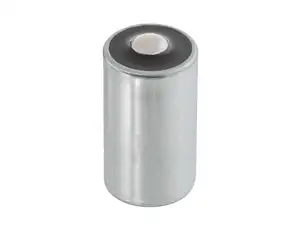
BOSCH capacitor for soldering (high) | Bosch / Ducati
Manufacturer: BOSCH · Ø outside: 18 mm · Height: 32 mm · Mounting type: Plug connection clamped · Connection type: Soldering · Area of application: Original · Area of application: Standard · Puch OEM number: 500 2 50 013 2 · Kreidler OEM number: 08 16 33 · Zündapp OEM number: 277 07 909 · BOSCH OEM number: 1 237 330 037 · Sachs OEM no.: 0 965 091 000
26,40 EUR

BOSCH screw-in condenser | Bosch / Ducati
Manufacturer: BOSCH · Capacity: 0.2 µF · Ø outside: 18 mm · Height: 27 mm · Mounting type: Plug connection clamped · Connection type: Thread for screwing · Thread type: M3x0.5 (standard thread) · Area of application: Original · Area of application: Standard · Alternative version of the Pony OEM number: A2090 · Pony OEM number: A2092 · Alternative version of the Sachs OEM number: 0265 052 003 · BOSCH OEM number: 2 207 330 050 · Sachs OEM no.: 0265 052 007
23,00 EUR

GPO ignition plate set 90 mm (Bosch, Ducati Replica)
Manufacturer: GPO · Material: Aluminum · Surface: dull · Color: gray · Tension: 6 V · Number of cables: 3 pcs · Cable length: 400 mm · Cable length: 500 mm · Ø inside: 18.5 mm · Ø outside: 90 mm · Number of fixing points: 4 pcs · Ø bolt circle: 80 mm · Area of application: Original · Area of application: Standard
86,50 EUR
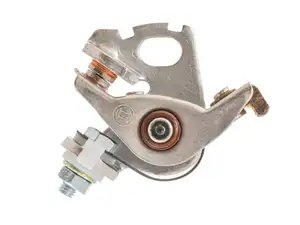
BOSCH Breaker without cable | Bosch / Ducati
Manufacturer: BOSCH · Material: Steel · Ø axle: 4 mm · Ø mounting hole: 4.5 mm · Cable available: No · Number of fixing points: 1 pcs · Area of application: Original · Area of application: Standard · BOSCH OEM number: 1 217 013 021 · BERU OEM number: 0 340 100 465
26,40 EUR

EFFE screw-in condenser | Bosch / Minarelli
Manufacturer: EFFE · Capacity: 0.22 µF · Ø outside: 18 mm · Height: 25 mm · Mounting type: Plug connection clamped · Connection type: Thread for screwing · Thread type: M3x0.5 (standard thread) · Area of application: Original · Area of application: Standard · Minarelli OEM number: 8201306 · BOSCH OEM number: 2 207 330 041 · BOSCH OEM number: 2 207 330 050
14,40 EUR

GPO light coil 6/12V - 15/25W
Manufacturer: GPO · Tension: 6 V · Tension: 12 V · Performance: 15 W · Performance: 25 W · Ø Internal flywheel: 90 mm · Height: 22 mm · Total length: 76.5 mm · Mounting type: Screws · Number of fixing points: 2 pcs · Ø mounting hole: 4.7 mm · Hole spacing: 55 mm · Area of application: Standard · Alternative version of the Pony OEM number: A2110 · Alternative version of the Sachs OEM number: 0265 113 004
23,00 EUR

BERU breaker without axle | Bosch ignition
Manufacturer: BERU · Material: Steel · Ø axle: 4 mm · Ø mounting hole: 4.5 mm · Cable available: No · Number of fixing points: 1 pcs · Area of application: Original · Area of application: Standard · Pony OEM number: A4606 · BOSCH OEM number: 1 217 013 015 · Sachs OEM no.: 0983 106 000 · BERU OEM number: 0 340 100 436
23,00 EUR

BERU breaker without cable | Bosch / Ducati
Manufacturer: BERU · Material: Steel · Ø axle: 4 mm · Ø mounting hole: 4.5 mm · Cable available: No · Number of fixing points: 1 pcs · Area of application: Original · Area of application: Standard · Alternative version of the Pony OEM number: A4606 · Alternative version of the Sachs OEM number: 0983 106 000 · BOSCH OEM number: 1 217 013 021 · BOSCH OEM number: 1 217 013 022 · BOSCH OEM number: 1 217 013 015 · BERU OEM number: 0 340 100 465
17,20 EUR

Light coil 6V with cable
Ø Internal flywheel: 90 mm · Total length: 76.8 mm · Ø mounting hole: 4.1 mm · Tension: 6 V · Performance: 17 W · Hole spacing: 54 mm · Height: 25.2 mm · Mounting type: Screws · Number of fixing points: 2 pcs · Area of application: Original · Area of application: Standard
21,80 EUR

Ignition coil | Puch / Sachs / Zündapp
Manufacturer: Quenching · Place of use: Internal (in the ignition) · Ø Internal flywheel: 90 mm · Ø cable holder: 6.4 mm · Cable length: 57 mm · Color: black · Total length: 76.5 mm · Height: 10.4 mm · Mounting type: Screws · Number of fixing points: 2 pcs · Ø mounting hole: 4.5 mm · Area of application: Original · Area of application: Standard
21,80 EUR

swiing® revival Bing float needle (with penetration) SRE, SRC, SRF, SRA, 85, 18
Manufacturer: swiing® revival parts · Component group Carburetor: Adjusting screws, float, etc. · Material: Aluminum · Material: Rubber · Surface: blank · Color: black · Color: silver · Carburetor type: SRA (1/11/35) Velux · Carburetor type: SRC · Carburetor type: SRE · Carburetor type: SRF · Carburetor type: 18 Catalyst · Carburetor type: 85 · Total length: 12 mm · Width: 3.3 mm · Ø outside: 2.6 mm · Ø outside: 4 mm · Alternative version of the Pony OEM number: A4595A · Alternative version of the Sachs OEM number: Bing 47-032
7,95 EUR

BING Float cap Bing Original SRE, SRC, SRF, SRA
Manufacturer: BING · Component group Carburetor: Adjusting screws, float, etc. · Material: Aluminum · Carburetor type: SRA (1/11/35) Velux · Carburetor type: SRC · Carburetor type: SRE · Carburetor type: SRF · Ø outside: 43.5 mm · Height: 32.5 mm · Width across flats SW: 14 mm · Piaggio OEM number: A4587 · Sachs OEM no.: 0962 056 000
21,80 EUR

BING O-ring Bing SRE & 85, Ø 20 mm
Place of use: Carburetor · Ø inside: 17.2 mm · Ø outside: 20 mm · Cord thickness: 1.4 mm · Color: black · Manufacturer: BING · Number of components: 1 pcs · Material: Rubber · Surface: raw · Area of application: Standard · Pony OEM number: A4281 · Sachs OEM no.: 0250 160 101
3,35 EUR

BOSCH Breaker with cable | Bosch / Ducati
Manufacturer: BOSCH · Material: Steel · Ø axle: 4 mm · Ø mounting hole: 4.5 mm · Cable available: Yes · Number of fixing points: 1 pcs · Area of application: Original · Area of application: Standard · Cable length: 100 mm · Ø Internal flywheel: 90 mm · Alternative version of the Pony OEM number: A4606 · Alternative version of the Pony OEM number: A4606A · Pony OEM number: A4607 · Alternative version of the Sachs OEM number: 0983 106 000 · Alternative version of the Sachs OEM number: 2783 039 001 · BOSCH OEM number: 1 217 013 025 · Sachs OEM no.: 0283 116 102 · BERU OEM number: 0 340 100 710
22,90 EUR

Bing 85/12/101 carburetor (replica) | Sachs 504, 505, 508, 535
Camouflaged: No · Component group Carburetor: Carburetor complete · Material: Aluminum · Carburetor type: 85 · Nominal diameter: 12 mm · Ø Internal connection: 20 mm · Ø Inside entrance: 12 mm · Ø Output inside: 12 mm · Air filter connection thread: M5x0.8 (standard thread) · Ø fuel hose connection: 6 mm · Mixed oil connection: No · Vacuum connection: No · Choke control: without choke · Nozzle thread: M4x0.7 (standard thread) · Nozzle size: 52 · Mounting type: Plug connection clamped · Total length: 48 mm · Width: 50 mm · Height: 100 mm · Area of application: Standard
98,00 EUR

PVL stator "1443" ignition
Manufacturer: PVL · Material: Aluminum · Surface: dull · Color: black · Color: gray · Number of cables: 2 pcs · Number of fixing points: 3 pcs · Area of application: High End · Area of application: MX · Area of application: Performance · Area of application: Racing · Area of application: Tuning
114,20 EUR

PVL ignition coil analog 105458 / 458115
Manufacturer: PVL · Place of use: External (outside the ignition) · Color: black · Mounting type: Screws · Number of fixing points: 2 pcs · Ø mounting hole: 6 mm · Area of application: High End · Area of application: MX · Area of application: Racing · Area of application: Tuning
114,20 EUR

EFFE breaker with cable | Bosch / Ducati
Manufacturer: EFFE · Material: Steel · Ø axle: 4 mm · Ø mounting hole: 4.5 mm · Cable available: Yes · Number of fixing points: 1 pcs · Area of application: Original · Area of application: Standard · Cable length: 100 mm · Ø Internal flywheel: 90 mm · BOSCH OEM number: 1 217 013 025 · BERU OEM number: 0 340 100 710
16,10 EUR

BERU breaker with cable | Bosch / Ducati
Manufacturer: BERU · Material: Steel · Ø axle: 4 mm · Ø mounting hole: 4.5 mm · Cable available: Yes · Number of fixing points: 1 pcs · Area of application: Original · Area of application: Standard · Cable length: 100 mm · Ø Internal flywheel: 90 mm · Alternative version of the Pony OEM number: A4606 · Alternative version of the Sachs OEM number: 0983 106 000 · BOSCH OEM number: 1 217 013 025 · BERU OEM number: 0 340 100 710
17,20 EUR

HPI racing ignition 12V with light 60W
Manufacturer: HPI · Material: Aluminum · Material: Steel · Tension: 12 V · Light coil voltage: 12 V · Performance: 60 W · Direction of rotation: left · Direction of rotation: right · Ø mounting plate: 90 mm · Ø Internal flywheel: 61.5 mm · Ø Flywheel outside: 71.5 mm · Ø cable: 7 mm · Mounting type: Screws · Number of fixing points: 6 pcs · Weight: 340 g · Area of application: Tuning
346,30 EUR

GPO flywheel 6V / 17W anticlockwise (Version 2.0) | Puch, Sachs, Belmondo
Manufacturer: GPO · Material: Steel · Tension: 6 V · Performance: 17 W · Direction of rotation: left · Weight: 900 g · Ø cone small inside: 11.5 mm · Ø cone large inside: 15 mm · Cone length: 18.5 mm · Cone ratio: 1:5 · Ø Internal flywheel: 91.1 mm · Ø Flywheel outside: 116.5 mm · Thread type: MF26x1.5 (fine pitch thread) · Thread length: 8 mm · Height: 36.1 mm · Pony OEM number: A2600 · Sachs OEM no.: 0286 175 005
101,50 EUR

BOSCH breaker without axle | Bosch ignition
Manufacturer: BOSCH · Material: Steel · Ø axle: 4 mm · Ø mounting hole: 4.5 mm · Cable available: No · Number of fixing points: 1 pcs · Area of application: Original · Area of application: Standard · Pony OEM number: A4606 · BOSCH OEM number: 1 217 013 015 · Sachs OEM no.: 0983 106 000 · BERU OEM number: 0 340 100 436
20,70 EUR

Bing 85/10/101 carburetor (replica) | Sachs 504, 535
Component group Carburetor: Carburetor complete · Carburetor type: 85 · Nominal diameter: 10 mm · Ø Internal connection: 20 mm · Air filter connection thread: M5x0.8 (standard thread) · Ø fuel hose connection: 6 mm · Nozzle thread: M4x0.7 (standard thread) · Nozzle size: 47 · Mounting type: Plug connection clamped · Area of application: Standard
98,00 EUR

BING 85/8/101 carburetor NOS | Sachs 504, 535
Manufacturer: BING · Component group Carburetor: Carburetor complete · Carburetor type: 85 · Nominal diameter: 8 mm · Ø Internal connection: 20 mm · Air filter connection thread: M5x0.8 (standard thread) · Area of application: Original · Ø fuel hose connection: 6 mm · Nozzle thread: M4x0.7 (standard thread) · Nozzle size: 48 · Mounting type: Plug connection clamped
126,90 EUR

GPO ignition plate set 90 mm with additional coil (Bosch, Ducati Replica)
Manufacturer: GPO · Material: Aluminum · Surface: dull · Color: gray · Tension: 6 V · Number of cables: 5 pcs · Cable length: 300 mm · Cable length: 400 mm · Cable length: 580 mm · Ø inside: 18.5 mm · Ø outside: 90 mm · Number of fixing points: 3 pcs · Ø bolt circle: 80 mm · Area of application: Custom · Area of application: Security · Area of application: Standard
103,80 EUR

BOSCH Breaker without cable reinforced | Bosch / Ducati
Manufacturer: BOSCH · Material: Steel · Ø axle: 4 mm · Ø mounting hole: 4.5 mm · Cable available: No · Number of fixing points: 1 pcs · Area of application: Tuning · Ø Internal flywheel: 90 mm · Alternative version of the Pony OEM number: A4606 · Alternative version of the Sachs OEM number: 0983 106 000 · BOSCH OEM number: 1 217 013 020 · BERU OEM number: 0 340 100 466
24,10 EUR

BOSCH capacitor for soldering (low) | Bosch / Ducati
Manufacturer: BOSCH · Ø outside: 18 mm · Height: 25.5 mm · Mounting type: Plug connection clamped · Connection type: Soldering · Area of application: Original · Area of application: Standard · Puch OEM number: 302 1 50 013 2 · Puch OEM number: 364 4 50 513 2 · Pony OEM number: A2090 · Zündapp OEM number: 266 07 903 · BOSCH OEM number: 1 237 330 035 · Sachs OEM no.: 0265 052 033 · Sachs OEM no.: 0265 052 003
23,00 EUR

swiing capacitor for soldering | Bosch / Ducati / Minarelli
Manufacturer: swiing · Capacity: 0.17 µF · Ø outside: 18 mm · Height: 22.5 mm · Mounting type: Plug connection clamped · Connection type: Soldering · Area of application: Original · Area of application: Standard · Garelli OEM number: 2085518980 · DKW OEM number: 0301-38505-00 · DUCATI OEM number: 113026 · DUCATI OEM number: 313026 · DUCATI OEM number: 11292600 · DUCATI OEM number: 11292690 · DUCATI OEM number: 11302600 · DUCATI OEM number: 11302690 · DUCATI OEM number: 30113026 · DUCATI OEM number: 331040290 · Pony OEM number: A2090 · Minarelli OEM number: 8201346 · Sachs OEM no.: 0265 052 003
13,70 EUR

HPI flywheel (Bosch/Ducati)
Manufacturer: HPI · Material: Steel · Direction of rotation: left · Direction of rotation: right · Ø cone small inside: 10.9 mm · Ø cone large inside: 15.8 mm · Cone length: 28 mm · Cone ratio: 1:5 · Ø Flywheel outside: 71.5 mm · Thread type: MF27x1 LH (fine/left-hand thread)
110,70 EUR

DUCATI ignition coil (1A quality)
Manufacturer: DUCATI · Place of use: Internal (in the ignition) · Ø Internal flywheel: 90 mm · Ø cable holder: 5.9 mm · Cable length: 37 mm · Color: black · Total length: 76.5 mm · Height: 17 mm · Mounting type: Screws · Number of fixing points: 2 pcs · Ø mounting hole: 4.6 mm · Hole spacing: 54 mm · Area of application: Original · Area of application: Standard · Alternative version of the Pony OEM number: A2116 · Alternative version of the Pony OEM number: A2118 · Pony OEM number: A2114 · Pony OEM number: A5524 · Alternative version of the Sachs OEM number: 0265 142 002 · Alternative version of the Sachs OEM number: 0265 142 004 · Sachs OEM no.: 0265 132 100 · Sachs OEM no.: 0265 203 001
74,90 EUR

GPO license plate holder Inox black
Manufacturer: GPO · Material: Chrome steel (known as Nirosta®) · Surface: varnished · Thread type: M5x0.8 (standard thread) · Color: black-matt · Total length: 147 mm · Width: 105 mm · Height: 6 mm · Ø mounting hole: 5 mm · Mounting type: Nuts & bolts · Number of fixing points: 6 pcs
14,90 EUR
Page 1 of 2
The development of the first motorbikes
In order to counter the economic misery, Trunkenpolz's plan was to enter into the production of vehicles. From 1951, the first light motorbike, the Moser-KTM 100 model, was therefore developed in cooperation with the Austrian engine specialist Rotax. At this time, the financially strong partner Ernst Kronreif also joined the company. With his financial resources, it was not only possible to start up and expand series production of two-wheelers, but the ‘K’ in the company name was also given a new meaning. From then on, the manufacturer was called KTM-Motorfahrzeugbau KG, Kronreif & Trunkenpolz Mattighofen. By the early 1960s, not only had production been increased, but the Austrian manufacturer's model range had also been diligently expanded. However, it would be a few more years before the first real mopeds left the factory in Mattighofen-Schalchen. Until then, the manufacturer launched the highly successful Tourist, Mustang and Tarzan motorbike models and scooters such as the Mecky, Mirabell, Ponny I and Ponny II models on the market.
Sporting successes in motocross and the first cross moped
Parallel to the development of new models, the manufacturer became involved in motorsport, which was becoming increasingly popular, and achieved considerable success both in road races and on race tracks. However, the machines developed by KTM were particularly successful in motocross or, as they used to say at the time, off-road sport. The launch of the Comet-Hödis in 1964 is certainly due to the special connection with motocross. This two-wheeler was one of the first genuine sports mopeds. As a Comet-Cross version, this slicer was a truly off-road machine and therefore a genuine pioneering two-wheeler, at least in this cubic metre class. In the version for the Austrian market, the Comet-Hödi was powered by a Puch V engine and delivered 2.6 hp. This two-wheeler was one of the most successful models of those years. Just two years after the start of production, 10,000 units had been produced and sold.
Foxi, SM 25 and KTM Ponys
However, the manufacturer did not rely on Puch engines for the numerous export versions of its other two-strokes. Most of the motorbikes that were developed and produced until the end of the 1970s were equipped with a Sachs 505 engine. This also applies to one of the manufacturer's most popular motorbikes, the Foxi model, which was not built until 1980. Thanks to an upside-down suspension fork, which incidentally was also used in the Zündapp models ZA10 and ZA20 in an identical design, and stereo shock absorbers on the rear wheel, rides on a Foxi moped are still a very comfortable affair today. The 1.36 hp output of this moped was also provided by a wind-cooled Sachs 505 engine, which was fuelled by a BING 85/10/101 carburettor, optionally in version A or B. Another child of the late 1970s and early 1980s is the KTM SM25 moped. In its day, this moped was regarded as a genuine top-of-the-range model. Its beefy look with a full-length seat is somewhat reminiscent of the competitor models G3 and GT from the manufacturer Hercules, which were launched shortly after the KTM moped. The first SM25 motorbikes were powered by Sachs 503 engines, while later models were equipped with a Sachs 506. During this time, the Austrians also took over the final assembly of the pony mopeds from Swiss manufacturer Amsler & Co. for several years. The two moped manufacturers had been working closely together since the mid-1960s. Initially, Amsler only purchased individual components for its Pony mopeds from the Austrians, but then decided to move the complete assembly to its eastern neighbour for cost reasons. The mopeds that were produced during this time therefore bore the unofficial name KTM Pony, not to be confused with the KTM Ponny scooter mentioned above. However, this episode was short-lived; after a few years, Amsler brought production back to its home town of Feuerthalen, where the mopeds are still produced to this day. In complete contrast to the KTM mopeds.

Decline and end of moped production
Although the Austrian moped manufacturer was still generating sales in the double-digit millions with its moped division in the mid-1980s, the company, which also produced bicycles and tools, got into financial difficulties, making insolvency and the subsequent break-up of the company unavoidable. This meant the end of moped production, while the other business divisions were spun off and in some cases continued in separate companies. KTM motorbikes, for example, continue to be built to this day under the umbrella of Pierer Mobility AG. However, the Foxi, Comet, SM 25 and other motorbikes from the manufacturer are still unforgotten to this day. The fact that you can still see one of the manufacturer's endearing mopeds on Swiss roads here and there is thanks to those enthusiasts who look after their mopeds with passion and love.
